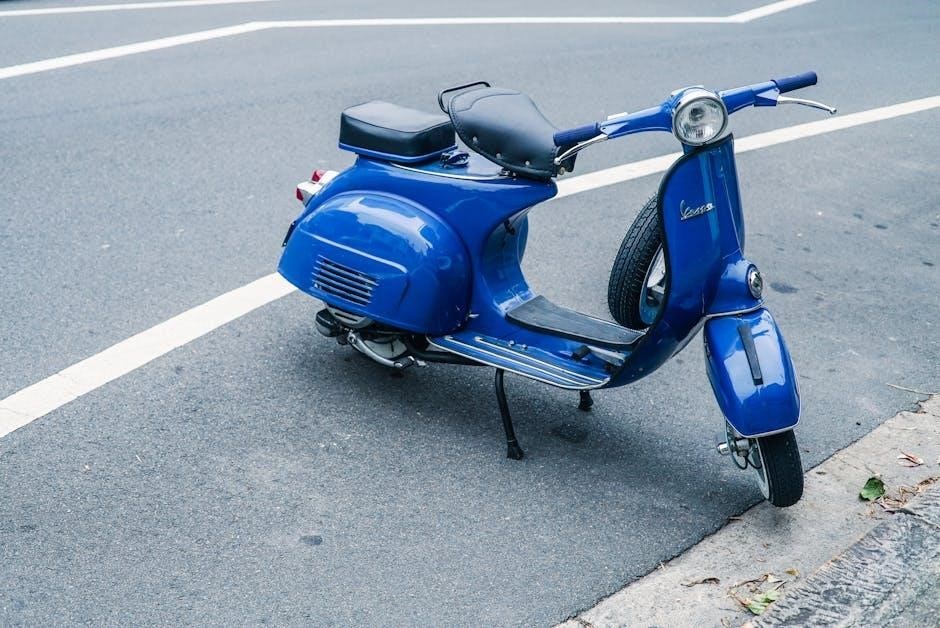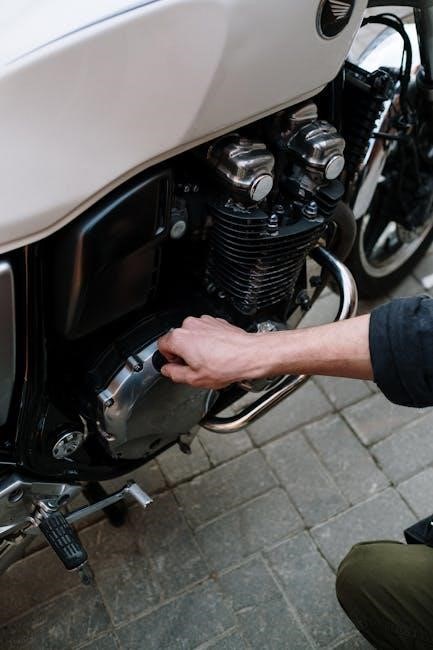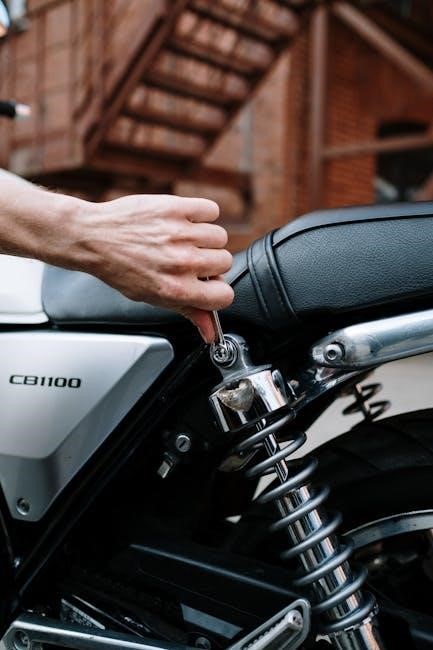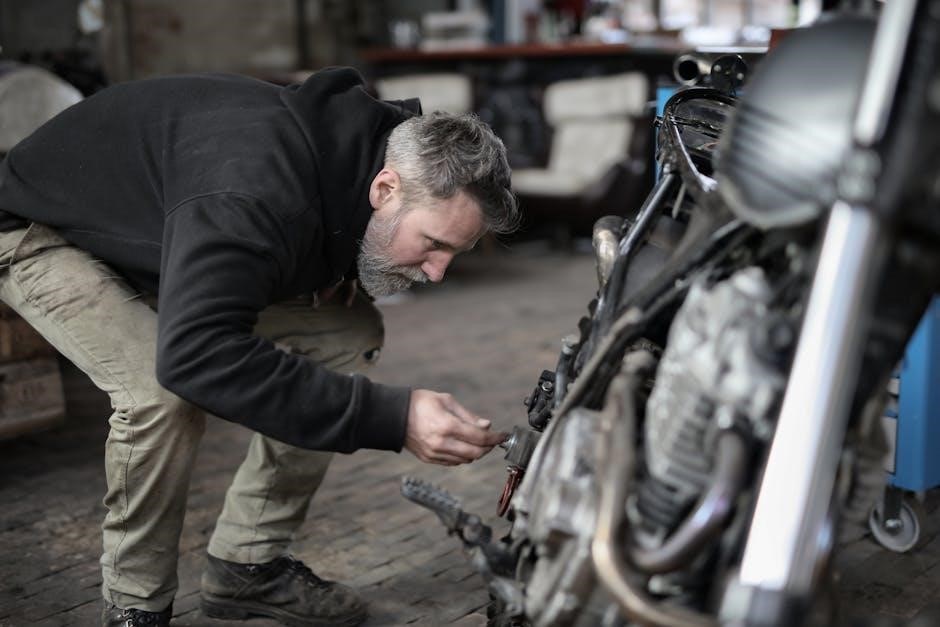The Pennsylvania Motorcycle Operator’s Manual is a comprehensive guide for motorcyclists, providing essential safety information, licensing requirements, and best practices for responsible riding in the state.
1.1 Overview of the Manual
The Pennsylvania Motorcycle Operator’s Manual is a detailed guide designed to help motorcyclists understand the rules of the road, safety practices, and licensing requirements. Published by PennDOT, the manual is part of a series that includes resources for drivers and motorcyclists alike. It covers essential topics such as pre-ride inspections, protective gear, and safe riding techniques. The manual also highlights Pennsylvania’s motorcycle safety programs and training courses. Whether you’re a new rider or an experienced motorcyclist, this manual serves as a valuable resource to ensure safe and responsible operation of a motorcycle on Pennsylvania’s roadways. It is available in both English and Spanish.
1.2 Importance of the Manual for Motorcyclists
The Pennsylvania Motorcycle Operator’s Manual is a crucial resource for motorcyclists, providing vital information to ensure safe and legal operation of motorcycles. It covers essential safety tips, legal requirements, and best practices to help riders avoid accidents and stay compliant with state laws. The manual emphasizes the importance of protective gear, pre-ride inspections, and defensive driving techniques. By following the guidelines outlined in the manual, motorcyclists can significantly reduce their risk of being involved in a collision. Additionally, it serves as a preparatory tool for obtaining a motorcycle license, ensuring riders are well-informed and equipped to handle the challenges of the road.

Licensing Requirements
The Pennsylvania Motorcycle Operator’s Manual outlines the necessary steps to obtain a motorcycle license, ensuring riders understand the requirements and application process to operate legally.
2.1 Eligibility Criteria for a Motorcycle License
To qualify for a motorcycle license in Pennsylvania, applicants must meet specific criteria. Riders must be at least 16 years old, with those under 18 requiring parental consent. A vision test is mandatory, ensuring candidates can safely operate a motorcycle. Additionally, applicants must pass a written knowledge test and a motorcycle skills test. PennDOT also requires proof of identity and residency. Completion of a motorcycle safety course is highly recommended, though not always mandatory, depending on age and experience. These requirements ensure that motorcyclists are prepared to handle the unique challenges of riding safely on Pennsylvania roads. Proper documentation and testing are essential steps in the licensing process.
2.2 Application Process and Required Documents
The process to apply for a motorcycle license in Pennsylvania involves several steps and requires specific documentation. Applicants must visit a PennDOT Driver License Center and complete Form DL-4 (Application for Driver’s License, Learner’s Permit, or ID Card) or DL-5 (for a motorcycle only). Required documents include proof of identity (e.g., birth certificate or passport), Social Security card, and two proofs of residency (e;g., utility bills or bank statements). A vision test and written knowledge test are mandatory. Applicants under 18 must provide parental consent. A fee is required, and applicants must pass a motorcycle skills test unless they complete a safety course. Proper documentation ensures compliance with PennDOT regulations.
2.3 Types of Motorcycle Licenses in Pennsylvania
In Pennsylvania, motorcycle licenses are categorized to accommodate different rider needs and experience levels. The most common license is the Motorcycle Operator’s License, which allows riders aged 21 and older to operate any motorcycle. For younger riders, the Junior Motorcycle License is available for those between 16 and 20 years old, but it restricts operation to motorcycles with an engine displacement of 50cc or less and a weight of 661 pounds or less. Additionally, a Learner’s Permit is available for individuals seeking to practice riding under supervision before obtaining a full license. Each license type ensures riders meet specific requirements and safety standards.

Safety Guidelines
Motorcycle safety guidelines emphasize protective gear, pre-ride inspections, and responsible riding practices. Always wear helmets and eye protection, check vehicle condition, and follow traffic laws to minimize risks.
3.1 Essential Protective Gear
Essential protective gear for motorcyclists in Pennsylvania includes a Department of Transportation (DOT)-certified helmet, eye protection, durable jackets, gloves, pants, and sturdy boots. Helmets must meet DOT or Snell standards to ensure safety. Eye protection, such as goggles or face shields, prevents debris from causing injuries. Jackets and pants should be made of abrasion-resistant materials, while gloves provide grip and protect hands. Boots should be high-ankle and have non-slip soles for better control. Additional gear like knee guards and back protectors can enhance safety. Wearing reflective or brightly colored clothing improves visibility. Proper protective gear significantly reduces the risk of injury in case of an accident.
3.2 Pre-Ride Inspections
Conducting a pre-ride inspection is crucial for safe motorcycling in Pennsylvania. Always check the tires for proper inflation, tread depth, and signs of wear. Inspect the brakes to ensure pads are not worn and fluid levels are adequate. Verify that all lights, including headlights, turn signals, and brake lights, are functioning. Check the oil and coolant levels, and ensure the chain or belt is properly tensioned. Test the suspension for responsiveness and inspect for any loose parts. Mirrors should be clean and adjusted for visibility. A thorough pre-ride inspection helps identify potential issues before they lead to accidents or breakdowns on the road.
3.3 Safe Riding Practices
Safe riding practices are essential for motorcyclists in Pennsylvania. Always position yourself in the center of your lane to maximize visibility and control. Maintain a safe distance from other vehicles, allowing time to react to unexpected situations. Avoid weaving in and out of lanes, as this increases the risk of collisions. Use brakes smoothly and gradually, especially in wet or slippery conditions. Signal early and clearly before turning or changing lanes. Stay alert and avoid distractions, such as using a phone while riding. Wear reflective or brightly colored clothing to increase visibility to other drivers. Never ride aggressively or beyond your skill level; These practices help reduce risks and enhance overall safety on the road.

Road Rules and Regulations
Motorcyclists must obey all Pennsylvania traffic laws, including speed limits, right-of-way rules, and traffic signals. Penalties for violations apply, and adherence ensures safer roads.
4.1 Speed Limits and Traffic Laws
Motorcyclists must obey all posted speed limits and traffic laws in Pennsylvania. Speed limits vary by location, with interstates typically allowing up to 70 mph, while urban areas have lower limits. Exceeding speed limits increases accident risks and may result in fines or license suspension. Motorcyclists are also required to follow all traffic signals, signs, and markings. Additionally, Pennsylvania law mandates that motorcyclists wear approved helmets and eye protection. Lane splitting, or passing between lanes of traffic, is prohibited in Pennsylvania. Riders must stay within their lane and exercise caution in heavy traffic. Adhering to these rules promotes safe and responsible motorcycling.
4.2 Right-of-Way Rules
Motorcyclists must always adhere to right-of-way rules to ensure safe interactions with other road users. At intersections, the vehicle that arrives first has the right-of-way. If two vehicles arrive at the same time, the vehicle on the right has precedence. Motorcyclists must yield to pedestrians, bicyclists, and emergency vehicles with active lights or sirens. When turning left, motorcyclists must yield to oncoming traffic. At roundabouts, motorcyclists should yield to traffic already in the circle. Always be visible and communicate intentions through signals to avoid conflicts. Defensive driving techniques, such as anticipating the actions of other drivers, are crucial for maintaining safety on Pennsylvania roads.
4.3 Traffic Signals and Signs
Motorcyclists must obey all traffic signals and signs to ensure safe and lawful riding. Traffic signals, including red, yellow, and green lights, dictate when to stop or proceed. Right-turn-on-red and straight-through arrows are also critical to follow. Traffic signs, such as stop signs, yield signs, speed limit signs, and directional signs, provide essential guidance. Motorcyclists should be particularly attentive to signs indicating sharp curves, school zones, or construction areas. Ignoring traffic signals or signs can lead to accidents and legal penalties. Always approach intersections cautiously and be prepared to react to changing signals or unexpected situations. Adhering to traffic signals and signs is vital for road safety in Pennsylvania.

Vehicle Inspection and Maintenance
Regular inspection and maintenance of your motorcycle ensure safety and performance. Always check tires, brakes, lights, and fluids before riding. Proper maintenance prevents mechanical failures and enhances reliability.
5.1 Pre-Ride Inspection Checklist
A pre-ride inspection is crucial for safety. Check tires for proper inflation and wear, ensure brakes function correctly, and verify all lights and signals are working. Inspect the chain or belt for tension and wear, and check fluid levels, including oil and coolant. Test suspension and exhaust systems for leaks or damage. Ensure mirrors are clean and securely mounted. Review all controls for proper function and check for any loose bolts or fasteners. Always follow the manufacturer’s guidelines and address any issues before riding to ensure a safe and reliable journey.
5.2 Regular Maintenance Requirements
Regular maintenance is essential for ensuring your motorcycle operates safely and efficiently. Schedule oil changes, tire inspections, and brake pad replacements as recommended by the manufacturer. Check and maintain proper air filter condition, and inspect the chain or belt for wear and tension. Battery health should be monitored, with terminals kept clean and secure. Regularly inspect and replace spark plugs, and ensure all fluids are at the correct levels. Following a consistent maintenance routine helps prevent mechanical failures, reduces long-term costs, and ensures your motorcycle remains reliable for safe riding. Always refer to your motorcycle’s service manual for specific guidelines.

Safe Riding Practices
Safe riding practices involve staying alert, maintaining control, and anticipating hazards. Always follow traffic laws, use signals, and keep a safe distance from other vehicles.
6.1 Defensive Driving Techniques
Defensive driving techniques are essential for motorcyclists to minimize risks on the road. Always stay alert, anticipate potential hazards, and maintain a safe following distance. Use your mirrors and check blind spots frequently. Be visible to other drivers by wearing reflective gear and positioning yourself in traffic where you can be easily seen. Avoid weaving in and out of lanes and never assume other drivers will see you. Stay focused on the road and avoid distractions. Follow traffic laws, including speed limits, and be prepared to react to unexpected situations. By adopting these practices, motorcyclists can significantly reduce their risk of being involved in an accident.
6.2 Group Riding Etiquette
Group riding requires coordination and communication to ensure safety for all participants. Always establish a leader to guide the group and a sweep rider to monitor from the rear. Maintain a staggered formation to allow space for maneuvering and avoid riding side by side. Use hand signals to communicate intentions, such as turning, slowing down, or hazards ahead. Keep a safe distance from the rider in front of you and avoid sudden movements. Stay alert to the actions of other riders and be prepared to adjust your position as needed. Plan stops and communicate the route beforehand to keep the group cohesive and informed.
6.3 Night Riding Safety Tips
Night riding presents unique challenges due to reduced visibility and increased risks. Always wear reflective gear and ensure your motorcycle’s headlights, taillights, and turn signals are functioning properly. Reduce your speed to allow more time to react to unexpected hazards. Maintain a greater following distance to compensate for limited visibility. Use high beams when appropriate but avoid blinding other drivers. Be cautious of oncoming traffic and avoid looking directly at headlights to minimize glare. Stay alert for pedestrians, animals, and debris, as they can be harder to spot at night. Plan regular breaks to rest and maintain focus during long rides.

Motorcycle Safety Program
PennDOT’s Motorcycle Safety Program enhances rider skills and awareness through training and resources, promoting safe riding practices and reducing accidents across Pennsylvania.
7.1 Overview of the Pennsylvania Motorcycle Safety Program
The Pennsylvania Motorcycle Safety Program, administered by PennDOT, is designed to reduce motorcycle accidents and fatalities through education and training. Offered to riders of all skill levels, the program emphasizes accident prevention, safe riding practices, and adherence to traffic laws. It provides courses tailored to both new and experienced motorcyclists, focusing on defensive driving techniques, hazard recognition, and proper vehicle control. The program is conducted by certified instructors and includes both classroom and on-bike training. By promoting responsible and informed riding, the initiative aims to enhance road safety for motorcyclists and other road users across Pennsylvania. Courses are available statewide and are free of charge.
7.2 Available Training Courses
The Pennsylvania Motorcycle Safety Program offers a variety of free training courses designed to improve riding skills and safety awareness. The Motorcycle Safety Foundation (MSF) Basic RiderCourse is available for new riders, teaching fundamental skills like braking, turning, and shifting gears. For experienced riders, the Intermediate RiderCourse refines techniques such as cornering and braking in traffic. Advanced riders can benefit from the Advanced RiderCourse, focusing on precision control and hazard management. Additional courses cover topics like night riding and group riding etiquette. All courses are conducted by certified instructors and include both classroom instruction and hands-on training to ensure a comprehensive learning experience.

Handling Emergency Situations
Handling emergency situations requires immediate action and knowledge of proper protocols. This section covers accident procedures, emergency maneuvers, and techniques to stay safe.
8.1 What to Do in Case of an Accident
In the event of an accident, prioritize safety and follow proper procedures. Move to a safe location if possible, and assess injuries. Call 911 immediately if anyone is hurt. Exchange information with all parties involved, including names, contact details, and insurance information. Document the scene with photos and notes. Notify the police to file a report, especially if injuries or significant damage occur. If required, report the accident to PennDOT within 30 days using the correct form. Seek medical attention promptly, even for minor injuries. Avoid admitting fault at the scene. Stay calm and cooperate with authorities to ensure a smooth process.
8.2 Emergency Maneuvers and Techniques
In emergency situations, motorcyclists must employ precise maneuvers to avoid collisions or minimize risks. Swerving requires quick, smooth steering input while maintaining balance. Hard braking involves applying both brakes firmly but controlled to prevent skidding. If the rear wheel locks, ease off the brake momentarily. For frontal skids, reduce throttle and avoid sudden inputs. Practice emergency stops in safe, open areas to build muscle memory. Always position your body weight correctly during maneuvers. Stay alert and anticipate potential hazards to react effectively. Regular training and practice are crucial to mastering these techniques and improving overall riding safety and control.

Environmental Impact
Motorcycles can impact the environment through emissions and fuel consumption. Eco-friendly practices, like regular maintenance and responsible riding, help reduce their environmental footprint in Pennsylvania.
9.1 Eco-Friendly Motorcycle Practices
Adopting eco-friendly motorcycle practices helps reduce environmental impact. Regular maintenance, such as oil changes and proper tire pressure, improves fuel efficiency and reduces emissions. Riders should avoid aggressive driving, as sudden acceleration and braking decrease fuel economy. Using lightweight, aerodynamic gear can also enhance efficiency. Additionally, planning routes to minimize idling and avoiding unnecessary trips contributes to a greener riding habit. Motorcyclists in Pennsylvania are encouraged to explore eco-friendly options, such as electric or hybrid motorcycles, and participate in programs that promote sustainable transportation. By embracing these practices, riders can help protect the environment while enjoying the freedom of the road responsibly.

Additional Resources
The PA Motorcycle Operator’s Manual is available online and in print. Additional resources include PennDOT’s website, local DMV offices, and motorcycle safety course materials.
10.1 Where to Find the Manual
The Pennsylvania Motorcycle Operator’s Manual is readily available through various sources. It can be downloaded for free from the Pennsylvania Department of Transportation (PennDOT) website. Additionally, physical copies can be obtained at local PennDOT driver’s license centers or motorcycle training locations. Many motorcycle safety courses also provide the manual as part of their training materials. For convenience, the manual is accessible in both digital and print formats, ensuring easy access for all motorcyclists. These resources help riders stay informed about traffic laws, safety practices, and licensing requirements in Pennsylvania.
10.2 PennDOT Contact Information
The Pennsylvania Department of Transportation (PennDOT) provides multiple ways to contact them for inquiries related to the motorcycle operator’s manual. Motorcyclists can visit the official PennDOT website at www.penndot.gov for detailed information and resources. Additionally, PennDOT can be reached by phone at 717-412-5300 during business hours. Their headquarters is located at 1101 South Front Street, Harrisburg, PA 17104. Motorcyclists can also access forms, FAQs, and other helpful materials on the PennDOT website. This ensures easy access to assistance for anyone seeking information about licensing, safety, or other motorcycle-related topics in Pennsylvania.
The Pennsylvania Motorcycle Operator’s Manual provides essential knowledge and skills for safe and responsible motorcycling. Always practice safe riding habits and follow state guidelines for a enjoyable experience.
11.1 Final Tips for Safe and Responsible Motorcycling
Always wear protective gear, including a helmet, gloves, and durable clothing. Stay visible by using reflective materials and ride defensively. Follow traffic laws and use signals consistently. Regularly inspect your motorcycle to ensure proper function and safety. Continuously improve your skills through training and practice. Plan routes carefully and avoid distractions while riding. Stay alert, especially in heavy traffic or poor weather conditions. Know your limits and never ride under the influence of alcohol or drugs. Secure loose items on your bike to prevent hazards. Keep a safe distance from other vehicles and be prepared for emergencies. By following these guidelines, you can enjoy motorcycling responsibly and safely in Pennsylvania.
